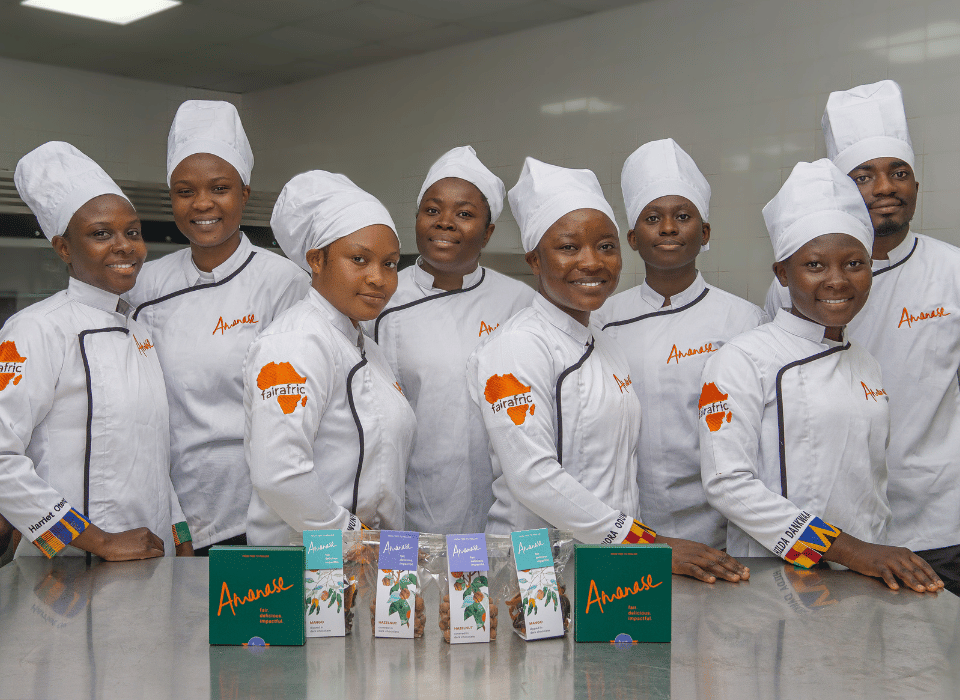On the way to the fairest chocolates in the world.
Value creation in the country of origin. Organic. Vegan. Plastic-free. Climate neutral. At Amanase, we are setting new standards in the chocolate industry, towards real change.
Together with our parent company fairafric, we will go one step further from 2024 and source our cocoa from dynamic agroforestry in Ghana, with the aim of producing climate-positive chocolate in the future. This reforestation and cultivation method allows a variety of different plant species to be planted - it is the opposite of monocultures. Together with Dr. Bronner's and our sister company Serendipalm, we are counteracting climate change and supporting cocoa farmers in earning a good living.
Where are we today? The consequences of monoculture.
Cocoa is traditionally grown in monocultures because farmers aim to achieve higher yields and income through this method. The paradox: This method of one-sided cultivation leads to a significant reduction in soil fertility in the long term. The continuous stress on the soil removes essential nutrients, makes the cocoa plants more susceptible to pests and diseases, increases susceptibility to erosion and ultimately results in declining crop yields.
Farmers often try to overcome these challenges by using chemical fertilizers and pesticides. However, in the long term, this does not achieve the desired results and instead contributes to harmful environmental impacts.
In addition, reliance on monocultures can affect farmers' income security. When cocoa prices fall, farmers who grow only cocoa face greater financial risk.
Dynamic agroforestry: an alternative to monocultures.
Dynamic agroforestry (DAF) aims to imitate the diversity and productivity of natural ecosystems and can therefore be seen as a solution to the consequences of monoculture. This cultivation method is based on the knowledge of the indigenous peoples of Latin America and combines many elements of regenerative agriculture. This means that the aim is to regenerate the soil and preserve biodiversity. This is why dynamic agroforestry relies on a symbiosis of different, complementary trees and plants.

Image: Dynamic agroforestry enables a much higher level of CO2 binding than conventional cultivation methods. Up to 4x more CO2 is bound in the soil.
The cocoa tree is a shade plant. This means that it needs larger trees above it, such as palm trees, to shade it. At DAF, the plants are therefore grown on different levels of the forest according to their needs. These levels consist of herbaceous plants and perennials, such as ginger and turmeric, shrubs and half-standards. In addition, various tree species are planted, such as crops, biomass or shade trees. It is of primary importance that the climatic conditions of the species are right. The ability to combine with the main crops, the preference of the farmers, the marketability and the availability of the planting material are ultimately decisive for the design of the DAF. Our partner Serendipalm plants avocados, citrus fruits, mangoes and cashews, among others.
Young cocoa grows optimally in combination with annual crops such as corn, beans and cassava. However, this is only the case in the first few years, when the cocoa is still small and there is enough light in the system for the annual crops. The annual crops are intended to secure income for the farmers as long as the cocoa and the other tree crops are not yet producing any yields. After three, or at the latest four years, the annual plants are removed from the system and other crops secure the farmers' income. Here the cocoa tree benefits in particular from the partial shade of perennial plants such as bananas and mangoes as well as precious wood trees, e.g. mahogany and cedar.
The organic material that is produced during the DAF cultivation method is left to decompose and serves as a natural fertilizer. But active management is also extremely important in DAF to ensure that enough light reaches the lower layers of the system at every stage so that all plants can thrive.
Benefits for the environment and cocoa farmers.
Dynamic agroforestry aims to produce as much biomass as possible, thereby improving soil quality. The production of biomass ultimately binds a large amount of CO2 in the long term.
In the long term, DAF can bind 4x more CO2 in the soil than is emitted in the value chain – this brings us step by step closer to the goal of climate positivity.
In addition, DAF promotes soil fertility, land productivity, water storage, plant and animal biodiversity, resilience to climate change and the production of healthy products. DAF makes cocoa plantations more resilient to pests and diseases because, among other things, the quality of the soil is improved in the long term. A natural balance between beneficial organisms and pests does not exist in a monoculture.
Image: One of a total of 321 cocoa farmers who already grow cocoa and other crops in the dynamic agroforestry.
Cocoa farmers also benefit from the Dynamic Agroforestry cultivation method. This not only enables consistently high yields, but also diversification and an increase in farmers' income. Savings on fertilizers and pesticides that farmers normally buy also contribute to this.
In addition to cocoa, DAF also grows other crops such as mangos and cashews. This not only provides the opportunity for self-sufficiency, but also a certain degree of resilience to fluctuations in the global cocoa price. In the four to five years after planting, when the cocoa is not yet bearing fruit, and outside of the cocoa harvest season, the other crops provide the farmers with an income.
These increased sources of income help address societal challenges such as child labor, nutritional deficiencies and rural migration to urban centers.
Our commitment: goals and successes.
Dynamic agroforestry is an absolute necessity in order to be able to produce chocolate in a truly sustainable way. Unfortunately, there are currently too few chocolate brands that use this cultivation method. Our goal is to change that and continuously increase the amount of cocoa beans from sustainable agroforestry systems in the future.
Image: DAF Farm in Ghana. More than 207,000 seedlings have been planted so far
To this end, we are working with Serendipalm , who are already working with 321 DAF smallholder farmers and training them in setting up and managing dynamic agroforestry systems. As part of the DEG project, 492 DAF plots have already been established on 302 hectares and 207,000 seedlings have been planted with financial support from the German Development Finance Corporation. When planting DAF fields, Serendipalm plants a total of 1,364 trees per hectare (92 timber trees, 208 biomass trees, 139 fruit trees of various varieties, 833 cocoa trees and 92 oil palms). In the long term, when the system is established, the number of biomass trees will be reduced by around 60% to make more space for the other crops.
Training of field workers by ECOTOP and Serendipalm 's own agro-engineers supports the farmers in the implementation and financing of the DAF project. The farmers also receive a lot of support in marketing additional products. The canteen currently under construction in the Montessori preschool will also be used in the future as a conference center for farmers, community and visitor groups to educate about regenerative agriculture and agroforestry.
In addition, the project generated 120 jobs: 90 employees in the technical team, 14 field staff, 8 employees to prevent child labour and raise awareness among farmers on this issue, 7 employees in the tree nursery and a DAF representative for market development.
Image: Cocoa farmer on her farm. A total of 120 jobs have already been created
Due to its positive impact on the environment and society
, Dynamic Agroforestry is indisputably the concept of the future, according to Vice President of Special Operations Gero Leson of
Dr. Bronner's , parent company of Serendipalm and market leader for fair natural soaps in the USA: “We're convinced that DAF is one of the most promising approaches on the planet to growing our food in a fair, sustainable, and profitable way. It is a win-win for the environment and for local farmers who earn a more reliable income, while reducing exposure to pesticides and herbicides.” Do you want to support us in growing more sustainable cocoa and becoming climate positive? Click here for the
climate bond from our parent company fairafric.
All images: © Courtesy of Serendipalm and Dr. Bronner's






